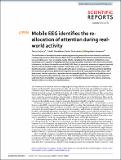Files in this item
Mobile EEG identifies the re-allocation of attention during real-world activity
Item metadata
| dc.contributor.author | Ladouce, Simon | |
| dc.contributor.author | Donaldson, David I. | |
| dc.contributor.author | Dudchenko, Paul A. | |
| dc.contributor.author | Ietswaart, Magdalena | |
| dc.date.accessioned | 2020-01-29T13:30:04Z | |
| dc.date.available | 2020-01-29T13:30:04Z | |
| dc.date.issued | 2019-11-01 | |
| dc.identifier | 266041361 | |
| dc.identifier | a4f5769a-e6ff-4b50-84eb-c4e31a00fd52 | |
| dc.identifier | 85074293305 | |
| dc.identifier | 31676780 | |
| dc.identifier.citation | Ladouce , S , Donaldson , D I , Dudchenko , P A & Ietswaart , M 2019 , ' Mobile EEG identifies the re-allocation of attention during real-world activity ' , Scientific Reports , vol. 9 , 15851 . https://doi.org/10.1038/s41598-019-51996-y | en |
| dc.identifier.issn | 2045-2322 | |
| dc.identifier.other | ORCID: /0000-0002-8036-3455/work/68281947 | |
| dc.identifier.uri | https://hdl.handle.net/10023/19378 | |
| dc.description | S.L., M.I. and D.I.D. are members of the SINAPSE collaboration (www.sinapse.ac.uk), a pooling initiative funded by the Scottish Funding Council and the Chief Scientific Office of the Scottish Executive. | en |
| dc.description.abstract | The distribution of attention between competing processing demands can have dramatic real-world consequences, however little is known about how limited attentional resources are distributed during real-world behaviour. Here we employ mobile EEG to characterise the allocation of attention across multiple sensory-cognitive processing demands during naturalistic movement. We used a neural marker of attention, the Event-Related Potential (ERP) P300 effect, to show that attention to targets is reduced when human participants walk compared to when they stand still. In a second experiment, we show that this reduction in attention is not caused by the act of walking per se. A third experiment identified the independent processing demands driving reduced attention to target stimuli during motion. ERP data reveals that the reduction in attention seen during walking reflects the linear and additive sum of the processing demands produced by visual and inertial stimulation. The mobile cognition approach used here shows how limited resources are precisely re-allocated according to the sensory processing demands that occur during real-world behaviour. | |
| dc.format.extent | 10 | |
| dc.format.extent | 1774767 | |
| dc.language.iso | eng | |
| dc.relation.ispartof | Scientific Reports | en |
| dc.subject | RC0321 Neuroscience. Biological psychiatry. Neuropsychiatry | en |
| dc.subject | DAS | en |
| dc.subject | BDC | en |
| dc.subject | R2C | en |
| dc.subject.lcc | RC0321 | en |
| dc.title | Mobile EEG identifies the re-allocation of attention during real-world activity | en |
| dc.type | Journal article | en |
| dc.contributor.institution | University of St Andrews. School of Psychology and Neuroscience | en |
| dc.identifier.doi | https://doi.org/10.1038/s41598-019-51996-y | |
| dc.description.status | Peer reviewed | en |
This item appears in the following Collection(s)
Items in the St Andrews Research Repository are protected by copyright, with all rights reserved, unless otherwise indicated.

